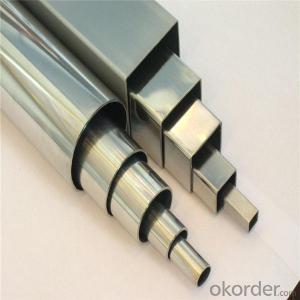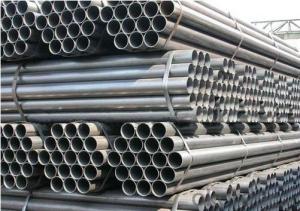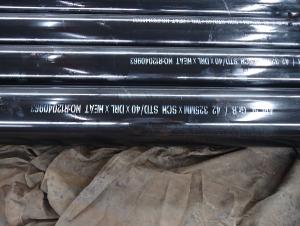321 Stainless Steel Pipe Price with SGS and BV approved
- Loading Port:
- Shanghai
- Payment Terms:
- TT OR LC
- Min Order Qty:
- 4 m.t.
- Supply Capability:
- 50000 m.t./month
OKorder Service Pledge
OKorder Financial Service
You Might Also Like
Specification
Details:
Description | stainless steel brake pipe |
Supply Capacity | 1500 tons/month |
Process Method | cold drawn and cold rolled |
Out Diameter | 6-711mm |
Wall Thickness | 0.3-120mm |
Length | 6-25 meters |
Steel Grade | 200 (Ni : 0.8%), 201B (Ni : 3%), 201H (Ni : 5%) |
301 (Ni : 6%), 304, TP304, TP304L/304L, 321, TP321, 316, TP316L, 316L, 316Ti | |
317, 317L, 309S, 310S(2520), 347, Duplex 2205, Duplex 2207, etc. | |
Standards | ASTM / ASME, GB, DIN, JIS, T14975, etc. |
Specification | O.D: 1/4" - 32" (inch) |
W.T: SCH5S, SCH10S,SCH40S,SCH80S,SCH160S,etc. | |
Or non-regular size to be tailored as required. | |
Application | Heat exchanger,Liquid delivery,Structure,etc. |
Packing | 1.with plastic cap to protect both ends |
2.plastic bag wrapped outside the pipe | |
3.bundles to be covered by polythene & strapped securely . | |
4.if require ,then pack into wooden box. | |
Certificate | ISO 9001:2008 |
Delivery time | 30-60 days depend on Quantity |
Payment Term | T/T, Irrevocable L/C at sight |
Trade Term | FOB , CFR , CIF |

Specifications of SS Tube 38mm:
1)Commodity:seamless stainless steel tube
2)Technique:cold and hot rolled
3)Surface:2B,HL,BK,NO.1,NO.4,NO.8,etc.
4)Material: TP304, TP304L, TP310 / S, TP316L, TP316 / 316L dual grade, TP317L, TP309/S, TP410,TP420,TP430,TP904L
5) Standards: ASTM ,AISI,etc.
6) Outer diameter:0.6mm-1200mm
7) Thickness:0.3mm-120mm
8) Length: as your requirement
9) Applications: for fluid and gas transport; structural and machining applications

Why choose us:
1. Independent warehouse & factory
2. Quick delivery (within 3-7 days)
3. Best service
4.High quality with reasonable price
5.High efficiency
6.Good reputation
7. Samples can be provided as your requirements.
- Q: How do you prevent oxidation in stainless steel pipes?
- Preventing oxidation in stainless steel pipes can be achieved through several methods. One way to effectively prevent oxidation is by applying a protective coating or finish on the surface of the pipes. Various types of coatings, including paints, epoxy, or polyurethane, can serve as barriers that prevent oxygen from coming into contact with the stainless steel, thus reducing the risk of oxidation. Furthermore, keeping the pipes clean and well-maintained is crucial in preventing oxidation. It is essential to eliminate any accumulated dirt, debris, or corrosive substances from the surface of the pipes. This can be accomplished using mild detergents or specialized cleaning agents specifically designed for stainless steel. Ensuring proper ventilation in the installation area is another preventive measure. Sufficient ventilation helps minimize the presence of moisture or humidity, which can accelerate the oxidation process. Additionally, keeping the pipes dry and avoiding prolonged exposure to water or moisture is vital in preventing oxidation. Lastly, selecting the appropriate grade of stainless steel for the intended application is important. Different grades of stainless steel offer varying levels of resistance to oxidation. For instance, austenitic stainless steel grades like 304 and 316 are highly resistant to oxidation and are commonly used in applications where corrosion resistance is crucial. In conclusion, employing a combination of preventive measures, such as protective coatings, regular cleaning, proper ventilation, and selecting the appropriate stainless steel grade, can effectively prevent oxidation in stainless steel pipes.
- Q: How are stainless steel pipes resistant to corrosion?
- Due to its unique composition and the presence of a protective oxide layer, stainless steel pipes possess corrosion resistance. The composition of stainless steel primarily consists of iron, chromium, and other alloying elements like nickel and molybdenum. The chromium content, typically above 10.5%, in stainless steel pipes creates a thin, invisible, and self-healing oxide layer on the pipe's surface. This oxide layer, known as the passive layer, serves as a protective barrier that prevents direct interaction between oxygen, moisture, and the underlying metal. It is this passive layer that grants stainless steel its corrosion-resistant properties. Even if the surface of the stainless steel pipe gets scratched or damaged, the passive layer renews itself and continues safeguarding the pipe against further corrosion. Moreover, stainless steel pipes may incorporate additional alloying elements such as nickel and molybdenum, which enhance their resistance against corrosion. Nickel enhances resistance against both general and localized corrosion, while molybdenum improves resistance against pitting and crevice corrosion. In conclusion, stainless steel pipes exhibit corrosion resistance due to a combination of their composition and the formation of a protective oxide layer. This characteristic makes them highly durable and suitable for various applications in industries where corrosion resistance is crucial, such as the chemical, oil and gas, and food processing industries.
- Q: What are the different types of stainless steel pipe gaskets?
- There are several different types of stainless steel pipe gaskets available, each designed to meet specific needs and requirements. Some of the most common types include: 1. Ring Type Joint (RTJ) Gaskets: These gaskets are used in high-pressure applications and are designed to withstand extreme temperatures and pressures. They feature a metallic ring with a soft sealing layer, which ensures a tight and reliable seal. 2. Spiral Wound Gaskets: This type of gasket is made by winding a metal strip and a filler material in a spiral shape. The metal strip provides strength and stability, while the filler material ensures a proper seal. Spiral wound gaskets are suitable for a wide range of applications, including high temperature and pressure environments. 3. Metal Jacketed Gaskets: These gaskets consist of a soft filler material enclosed in a metal jacket. The metal jacket provides additional strength and protection, making them suitable for high-pressure applications. Metal jacketed gaskets are commonly used in flange connections. 4. Camprofile Gaskets: Camprofile gaskets are composed of a metal core with concentric grooves on both sides. These grooves are filled with a soft sealing material, which provides an effective seal. They are commonly used in applications where high temperature and pressure resistance is required. 5. Double Jacketed Gaskets: Double jacketed gaskets consist of two metal jackets with a soft filler material in between. This design provides enhanced sealing performance and is often used in applications involving high temperatures and pressures, as well as corrosive environments. 6. Elastomeric Gaskets: These gaskets are made from a variety of elastomeric materials such as rubber or silicone. They are commonly used in low-pressure applications and provide excellent sealing properties. Elastomeric gaskets are cost-effective and easy to install. It is important to select the appropriate type of stainless steel pipe gasket based on the specific application requirements, including temperature, pressure, and the nature of the fluid being transported. Consulting with a knowledgeable supplier or engineer can help ensure the correct gasket is chosen for the intended use.
- Q: What is the thermal conductivity of stainless steel pipes?
- Depending on the specific grade and composition of stainless steel, the thermal conductivity of stainless steel pipes can vary. On average, the thermal conductivity of stainless steel ranges from 14 to 19 watts per meter Kelvin (W/mK). This indicates that stainless steel pipes exhibit relatively efficient heat conduction, facilitating the transfer of thermal energy. Consequently, stainless steel pipes are well-suited for a multitude of applications that necessitate heat transfer, including heating systems, industrial processes, and certain plumbing installations.
- Q: Can stainless steel pipes be used in harsh environments?
- Yes, stainless steel pipes can be used in harsh environments. Stainless steel is highly resistant to corrosion, rust, and high temperatures, making it suitable for a variety of challenging conditions such as chemical processing plants, offshore oil rigs, and industrial settings. Its durability and resistance to environmental factors make it a reliable choice for harsh environments.
- Q: Are stainless steel pipes suitable for underground sewage systems?
- Certainly, underground sewage systems benefit greatly from the use of stainless steel pipes. Renowned for their resilience, robustness, and resistance to corrosion, stainless steel pipes prove to be an optimal selection for subterranean applications. With an extended lifespan, they can endure the demanding circumstances commonly encountered in sewage systems, such as exposure to moisture, chemicals, and fluctuating temperatures. Furthermore, the smooth interior surface of stainless steel pipes serves to prevent the accumulation of debris or waste, effectively decreasing the likelihood of clogs or obstructions. In summary, stainless steel pipes present a dependable and enduring solution for underground sewage systems.
- Q: What is the standard size range for stainless steel pipes?
- The standard size range for stainless steel pipes varies depending on the industry and application. However, in general, stainless steel pipes are available in a wide range of sizes, starting from small diameters of around 0.5 inches (12.7 mm) to large diameters of up to 48 inches (1219 mm) or even larger in some cases. The wall thickness of stainless steel pipes can also vary, ranging from thin-walled pipes with a thickness of a few millimeters to heavy-walled pipes with thicknesses exceeding an inch. The specific size range for stainless steel pipes may be determined by factors such as the intended use, pressure requirements, and industry standards. It is important to consult relevant specifications and standards to determine the appropriate size range for a specific application.
- Q: What are the different finishes available for stainless steel pipes?
- There are several different finishes available for stainless steel pipes, including brushed, polished, satin, and mill finishes. These finishes can vary in appearance and texture, allowing individuals to choose the one that best suits their desired aesthetic and functional needs.
- Q: What kind of welding machine is used for welding thin stainless steel plate and stainless steel square tube?
- But I've already attached a ban on reverse welding (the reverse side is a square tube frame)3. I want it to look good after welding.I was just 4. when reading practice a week of welding, can actually be said to have no understanding of welding after graduation, occasionally with ordinary welding iron will often appear in the weld the warning signs, the other is capable person, not a child, he should be responsible for his behavior. Irrigation can not go fishing? We must also be jointly and severally liable for an accident
- Q: How do stainless steel pipes differ from other types of pipes?
- Stainless steel pipes differ from other types of pipes primarily due to their corrosion-resistant properties, which make them highly durable and long-lasting. Unlike other pipes, stainless steel pipes are less prone to rusting or corroding, making them suitable for a wide range of applications, particularly in industries where hygiene and cleanliness are essential. Additionally, stainless steel pipes have high strength and heat resistance, making them capable of withstanding extreme temperatures and pressures, making them a preferred choice for various industrial and commercial applications.
Send your message to us
321 Stainless Steel Pipe Price with SGS and BV approved
- Loading Port:
- Shanghai
- Payment Terms:
- TT OR LC
- Min Order Qty:
- 4 m.t.
- Supply Capability:
- 50000 m.t./month
OKorder Service Pledge
OKorder Financial Service
Similar products
Hot products
Hot Searches
Related keywords


























